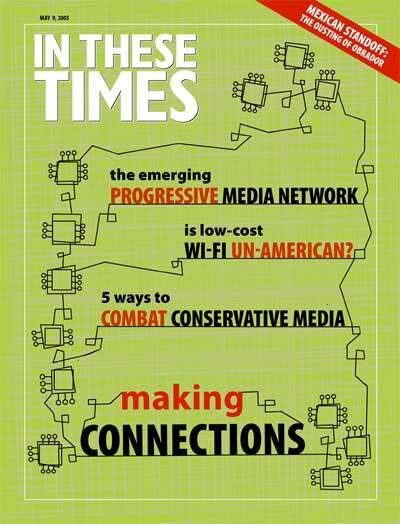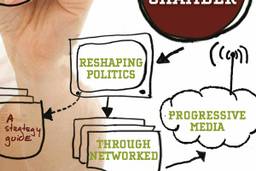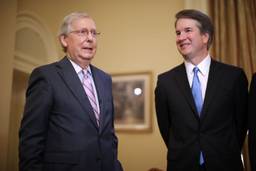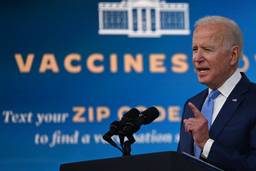Making Connections
Why is the news so bad? What can progressives do to fix it?
Jessica Clark and Tracy Van Slyke
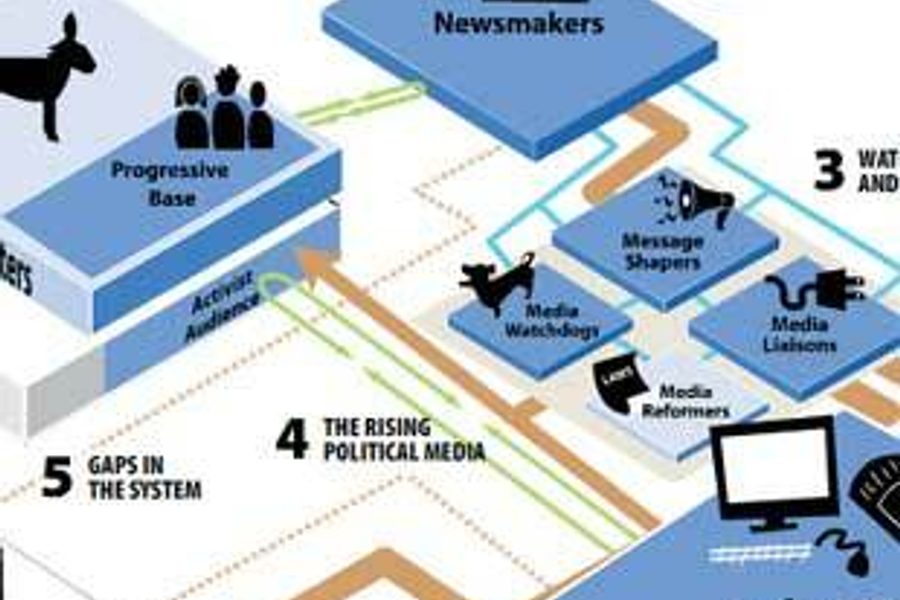
In March, conservative uber-strategist Grover Norquist of Americans for Tax Reform launched the Media Freedom Project. This new group is the latest entry in a three-decade-long contest between the progressives who want to protect and extend First Amendment rights to freedom of speech and those on the right who view unfettered expression as a danger to the established corporate order.
The Media Freedom Project’s first press release, “The Return of the Re-Regulators,” warned that Democratic efforts to reinstate the Fairness Doctrine “could mean the end of popular talk show hosts such as Rush Limbaugh, Sean Hannity and G. Gordon Liddy.” (See “Fairness Now,”)
The Media Freedom Project’s priorities show why the Fairness Doctrine, which compelled FCC-licensed broadcasters to “afford reasonable opportunity for discussion of conflicting views on matters of public importance,” is sorely needed in what commentators like the Media Channel’s Danny Schecter are calling a “post-journalism era.”
Decades-old journalistic standards of “objectivity”- — and even its less-learned cousin, “balance” — are on the ropes. Paid political operatives posing as bloggers are taking down journalists like Dan Rather, while progressive “citizen bloggers” expose faux-reporters like Jeff Gannon. (See “The Blogosphere: Insiders vs. Outsiders,”) The federal government is filling the airwaves with “video news releases” and hired pundits like Armstrong Williams. (See “The GOP’s Quest for Color,”) Meanwhile, a study by the University of Pennsylvania’s National Annenberg Election Survey revealed that young people who regularly watch “The Daily Show” are “more likely to answer questions about politics correctly than those who don’t.”
With this issue of In These Times, we explore the contours of the current media landscape, map the contested territory, and chart the dissimilar conservative and progressive media strategies.
How the conservatives came to dominate
The story of how conservatives have reshaped the media to their own ends has generated plenty of ink. Fairness and Accuracy in Reporting (FAIR) founder Jeff Cohen, Salon’s Joe Conason and The Nation’s Eric Alterman have all written convincingly and at length for both mainstream and progressive outlets about how right-wing media has come to dominate the national debate.
Reformed conservative David Brock explains in The Republican Noise Machine that tarring the mainstream media as “liberal” was the first step in the conservative campaign to dominate the airwaves. Founded in 1969 by anti-communist economist Reed Irvine, Accuracy in Media (AIM) was set up to support President Richard Nixon’s Vietnam policies by mobilizing opposition to “liberal” bias in the news. “Irvine was practicing a form of jujitsu” writes Brock. “Seeing itself as a public trust, the media was responsive to calls for accountability and was highly susceptible to criticism.” Dan Rather was one of the group’s targets during that era and has remained so to this day. AIM mocked his patriotic final broadcast as an “extreme makeover.”
Inculcating fear of conservative disapproval in the mainstream press — and a consequent alienation of advertisers and viewers — has been the lynchpin of the conservative strategy. It set the stage for the creation of a conservative media machine. In an effort to shift public discourse to the right, conservative foundations, right-wing donors and corporations worked together to create multiple organizations that in turn generated think tanks, issue-based nonprofits and conservative media outlets — all with their own highly paid and well-coached “experts.” Then, the right, ever more loudly denouncing the biased “liberal media elite,” inserted these newly minted experts into a mainstream media that was now on the defensive and vulnerable to manipulation.
The goals of the conservative media strategy are multiple and overlapping: to protect business interests, elevate a free-market philosophy, advance a frame of “family values,” promote U.S. political dominance, and counter popular movements for civil, women’s, consumers’ and gay rights that were gaining prominence in the late ’60s and early ‘70s. The traditional Republican right found ready allies in leaders of the Christian right like Pat Robertson, who in 1960 founded the Christian Broadcasting Network, which by the late ‘70s reached millions of viewers and regularly featured prominent conservatives.
During the ’70s and ’80s, conservative and corporate funders followed an explicit plan to establish and expand right-wing think tanks such as the Cato Institute, the Heritage Foundation and the American Enterprise Instititue. The think tanks served as incubators for right-wing ideas and by the ’90s were poised to capitalize on emerging — and unregulated — media sectors such as cable television, talk radio and Internet commentary. They were complimented by a host of corporate-funded “astroturf” groups created by the public relations industry to counteract genuine grassroots organizations fighting for social, environmental and economic justice.
Like the Bush presidencies, the rise of a conservative media machine has been an elaborate, multi-generational affair. AIM’s late-’60s media criticisms were complemented by the critiques of Irving Kristol, the influential co-editor of the conservative journal The Public Interest. Irving is the father of William Kristol, who founded the prominent conservative magazine The Weekly Standard in 1995 with funding from Fox News owner Rupert Murdoch. Small political magazines like these, despite their low circulation, have been standard-bearers for once-radical ideas that have now moved into the mainstream. After several years of editing The Weekly Standard, the younger Kristol used grants from the Bradley Foundation to establish the Project for the New American Century, a nonprofit organization of neoconservative activists who hatched the rationale for President George W. Bush’s war in Iraq.
While Murdoch’s support for The Weekly Standard has been instrumental in the recent history of conservative media, it’s his Fox News that represents the pinnacle of right-wing media strategizing — a 24-hour station, available to all cable subscribers that militantly masquerades as a “fair and balanced” member of the mainstream media. According to an analysis by the Project for Excellence in Journalism, in 2004 Fox News anchors and reporters included their own opinions in 73 percent of the stories they reported on Iraq. In contrast, only 2 percent of CNN reporters did so. The report notes, “Those findings seem to challenge Fox’s promotional marketing, particularly its slogan, ‘We Report. You Decide.’ ”
The 24-hour news cycle has also spawned its own virulent brand of media manipulation: repetitive, coordinated and incessant. For example, every Wednesday morning, the Media Freedom Project’s Norquist convenes an invitation-only meeting of high-level GOP strategists, Congressional and White House staffers, and corporate leaders to formulate the “talking points” for the week. In a January 2004 profile of Norquist in Mother Jones, Michael Scherer wrote:
There is no time for canned political rhetoric. The focus is on winning. Here, strategy is honed. Talking points are refined. Discipline is imposed. … In building his coalition, Norquist has made a conscious strategic decision to go with a big-tent approach. At his weekly meetings, social issues like gay rights and abortion, which can divide the electoral base of conservatives and libertarians, are played down in favor of issues like tax cuts, tort reform, and the rollback of federal regulations and rules. These are the broad-appeal political winners on which Norquist is pinning the movement’s future. And they’re a strong lure for the corporate community, some of whose members — Philip Morris, Pfizer and Time Warner, for instance — also happen to supply funding for Americans for Tax Reform.
Where does this leave progressives? Stuck, as they are, with defending old-fashioned values, such as truth, fair play, factual accuracy, civility, the open exchange of ideas, the power of reasoned debate, and the honor of upholding the public trust.
Progressives face a predicament
In contrast to conservatives, progressives have done little to internally define “who we are,” “what values we stand for” and “what we want.” Lacking an agreed upon framework, progressives spread singular messages, resulting in a cacophony rather than an outline of a progressive agenda.
In early December, William Safire quoted James Carville’s take on the matter in the New York Times Magazine: “They produce a narrative, we produce a litany. … They say, ‘I’m going to protect you from the terrorists in Tehran and the homos in Hollywood.’ We say, ‘We’re for clean air, better schools, more health care.’ And so there’s a Republican narrative, a story, and there’s a Democratic litany.”
The challenge for progressives is to create narratives that express progressive values. Progressives must develop the strength of speaking with a unified voice, one that communicates our fundamental beliefs while still drawing on the diversity of perspectives integral to progressive principles.
Currently, the progressive media network is missing both a coordinated messaging system and a self-sustaining network that can funnel ideas from the grassroots, progressive think tanks and the independent media into the mainstream media where national conversations take place.
In a 2002 report on progressive think tanks for the Open Society Institute, David Dyssegaard Kallick wrote, “What is lacking is not sharp individuals with creative ideas. … What is missing is an institutional infrastructure that brings these people together with each other and with people who understand practical politics, media and organizing.”
For decades, liberal foundations and individual donors have failed to recognize the need for building long-term capacity in progressive media and affiliated organizations, and thereby create a progressive “echo chamber” that can begin to counter the right’s media machine. Progressive foundations, with their roots in the reform movements of the early 20th century, have focused on funding social work and single-issue groups.
As a result, the progressive media network has evolved in an ad hoc, organic basis in contrast to the conservative media machine’s coordinated infrastructure. Progressive media is built by unconnected individuals who have in common the belief that the progressive agenda needs a voice of its own. When liberal foundations do provide media grants, they shy away from overtly political media projects, and instead direct millions toward federally supported public media, such as the Public Broadcasting System (PBS) and National Public Radio, or to individual documentary film projects that might be shown on PBS.
In their 2003 report “Funding for Social Change,” Nan Rubin and Sharon Maeda write, “Progressive funders do not provide much support for infrastructures, distribution networks and membership organizations that provide the political and technical backbone for ‘alternative media’ to reach audiences.”
They also note in a 2005 update to their survey that while foundations recognize the dangers of corporate media consolidation and the importance of organizing around media, they have little understanding of how to strategically fund media development or how to document its impact. “Few funders see media as an organizing tool or as a way to popularize messages or conduct public education campaigns,” Rubin and Maeda write, “Primarily, though, they address the concept of the message and not the media themselves.”
A media network emerges
Recently, new think tanks, such as the Center for American Progress and the Rockridge Institute, have started disseminating progressive messages, providing talking points and conducting fact-finding missions to discredit the misinformation coming from conservative think tanks and pundits. On-line mobilizing groups such as MoveOn and progressive 527s like Americans Coming Together have reenergized a progressive voter base that is politically engaged and active.
Yet these Washington-centric efforts are still not connected to grassroots, single-issue organizations. Too often, they lack the involvement of women, people of color and those who are not upper-middle class.
Looking at “The Emerging Progressive Media Network,” it’s important to note the disconnect between the vast, well-funded “Issue-Based Nonprofits,” the “Emerging Message Machine” of the think tanks, politicians and message creators and the struggling “Progressive Media.” To participate in the mainstream dialogue, each of these spheres needs to be connected to each other and appropriately funded.
So what are the next steps?
- Progressive media makers should reach out to and educate foundations and individual donors about the strategic importance of providing significant funding to independent media outlets in order to build a sustainable progressive infrastructure that can effectively shape public dialogue.
- Progressive strategists should develop narrative frames and talking points that can successfully carry their values into the mainstream media. This will require an unprecedented level of cooperation among the disparate collection of independently run and funded organizations that currently make up the progressive movement.
- Progressive organizers should continue discussing ways to strengthen their media network without mimicking the top-down, undemocratic methods of the right’s media machine. Supporting current infrastructure groups — and building new ones — is key to improving coordination between the different progressive media sectors. This will require financial resources and research.
- Progressives of all stripes should look for inspiration from innovative models of participatory information-sharing, such as the collective idea development pioneered in open-source networks, or the community-driven organizing of MoveOn’s house parties and Democracy For America’s meet-ups. New technological opportunities offered by advances like community Wi Fi also open up fresh media horizons.
These recommendations are only a start. Like the progressive media network itself, this analysis will continue to evolve. The prospects are exciting, but both financial support and dialogue are needed to reach the next level.

I hope you found this article important. Before you leave, I want to ask you to consider supporting our work with a donation. In These Times needs readers like you to help sustain our mission. We don’t depend on—or want—corporate advertising or deep-pocketed billionaires to fund our journalism. We’re supported by you, the reader, so we can focus on covering the issues that matter most to the progressive movement without fear or compromise.
Our work isn’t hidden behind a paywall because of people like you who support our journalism. We want to keep it that way. If you value the work we do and the movements we cover, please consider donating to In These Times.
Tracy Van Slyke, a former publisher of In These Times, is project director of The Media Consortium and co-editor of buildtheecho.net. Clark and Van Slyke are the co-authors of Beyond the Echo Chamber: Reshaping Politics Through Networked Progressive Media (2010, New Press)
